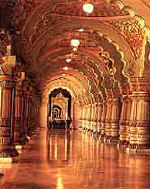Tour Guides and Tusks
The Wodeyar’s Palace, Mysore, India


Palace hall
![]()
![]()
We walk in from the vast courtyard into coolness of the Wodeyar’s palace. The path, intricately tiled in maroon, black and ivory leads us into a hall, lined from floor to ceiling with murals. Men, princes, soldiers, horses and kings float in front of our eyes, and we aren’t quite certain what its all about until we stop to listen to a large man, dressed in electric white, with gold-rimmed sunglasses. The palace tour guide.
He is reeling off information. “He fought. He won. Not died. If you can answer me where throne is today, you will be most happy to dine with me at Lalit Mahal. Three guesses. Anyone know?” He beams at his little group. Whether no one knows the answer, or whether having dinner with him is a daunting prospect, I’m not sure, but no one volunteers. He zeroes in on a little Japanese man. “Sir, take try. Which country?”
The Japanese tourist hesitates. “Holland?”
“You are most right!” the guide pumps his hand ecstatically. “You join me for dinner later.”
Then he spots us, straining to listen, at the back of the group. “You!” he bellows. “You are accepting to pay small fee of hundred rupees?”
Everyone turns to look at us. One hundred rupees for a tour! We nod meekly anyway.
We learn a little as we go along, even though our guide is not given to historical accuracy. The Mysore Palace was built in 1901, after the original wooden palace was burned down during a wedding celebration. His Highness, Krishnaraja Wodeyar Bahadur, who built the imposing residence, is felicitated in every corner. There are portraits of him and his family, murals of the king at Dussera celebrations, and even a life-sized statue of him holding court.
At the center of the hall, the ceiling extends upward to a stained glass dome. The glass, painted in a pattern of peacock feathers, is spectacular in its detail. Elaborate arches are topped with the sculpted heads of elephants or horses.
We walk in silence up to the second floor, where the paintings of the Mahabharata and the Ramayana by two artists from Travancore, are displayed. Our guide walks us through the paintings, explaining expressively the great merits of the two epics, and the “culture importance” they hold. He stops in front of a painting of the Goddess Lakshmi, and looks at the Japanese man.
“How many years you married, sir?”
The little man stares awhile. “Thirty years”, he says.
“And your wife is your good fortune?”
The man’s wife turns to him, and the little man has no option but to nod. Our guide continues. “Yes. Wife is bank. Bank of love. Concern. But for this bank, you must give more money than you take out.” He waits for the crowd to crack a smile, then guffaws and hurries on.
We climb a flight and find ourselves at the entrance of the Amar Vilas Durbar, the hall used by the king to meet his courtiers, speak to his people, or celebrate occasions. On the right, is a carved wooden elevator – the first to be used in India. Constructed from Burma teak, like all the doors and some of the ceilings in the palace, the elevator is tiny, only a little over five feet in height.
The king’s entrance to the durbar, a great door, made entirely from silver, still stands. We enter and are immediately struck by the richness of the room. The walls and ceiling are sculpted, as they are in the other rooms of the palace, but here, the ceiling is inlaid with jasper, cornelian, and lapis lazuli. Ivory carvings adorn the walls, and the pillars are painted in gold, royal blue and crimson. The view from this room takes in the entire courtyard, and is where the king would sit to be entertained, or watch a cultural programme. Our guide points out the huge mirrors that are placed at intervals along the halls. “This is for checking the turban. No one could sit for function not wearing turban. If someone came without turban, he must pay one rupee, and take turban from king’s store.”
“How much was spent on the building of the palace?” someone asks.
Our guide raises his eyebrows. “I already have told you before. You not listen. Forty-two lakhs. You are welcome to His Highness’ throne room.” He snorts and moves on. No one asks another question.
The throne room is a comparatively small room, draped in deep red velvet. Two silver thrones are placed on either side of a framed painting. Two ivory tusks frame the painting, of an elephant at a Dussera procession. The tusks belonged to Gajendra, the king’s favorite elephant.
Last, we are led into the Palace Museum, which contains weapons and armour, personal belongings of the royal family, and a beautiful bronze palanquin, used to transport the Queen and the princesses.
The end of our tour. But our guide is not quite finished.
“You can purchase this beautiful palanquin for rupees two only. King’s throne is yours for rupees three. You can purchase entire palace for only rupees three.”
We look at each other, wondering if we’ve misunderstood something.
Our guide winks. “Visit postcard shop at exit.”
——–